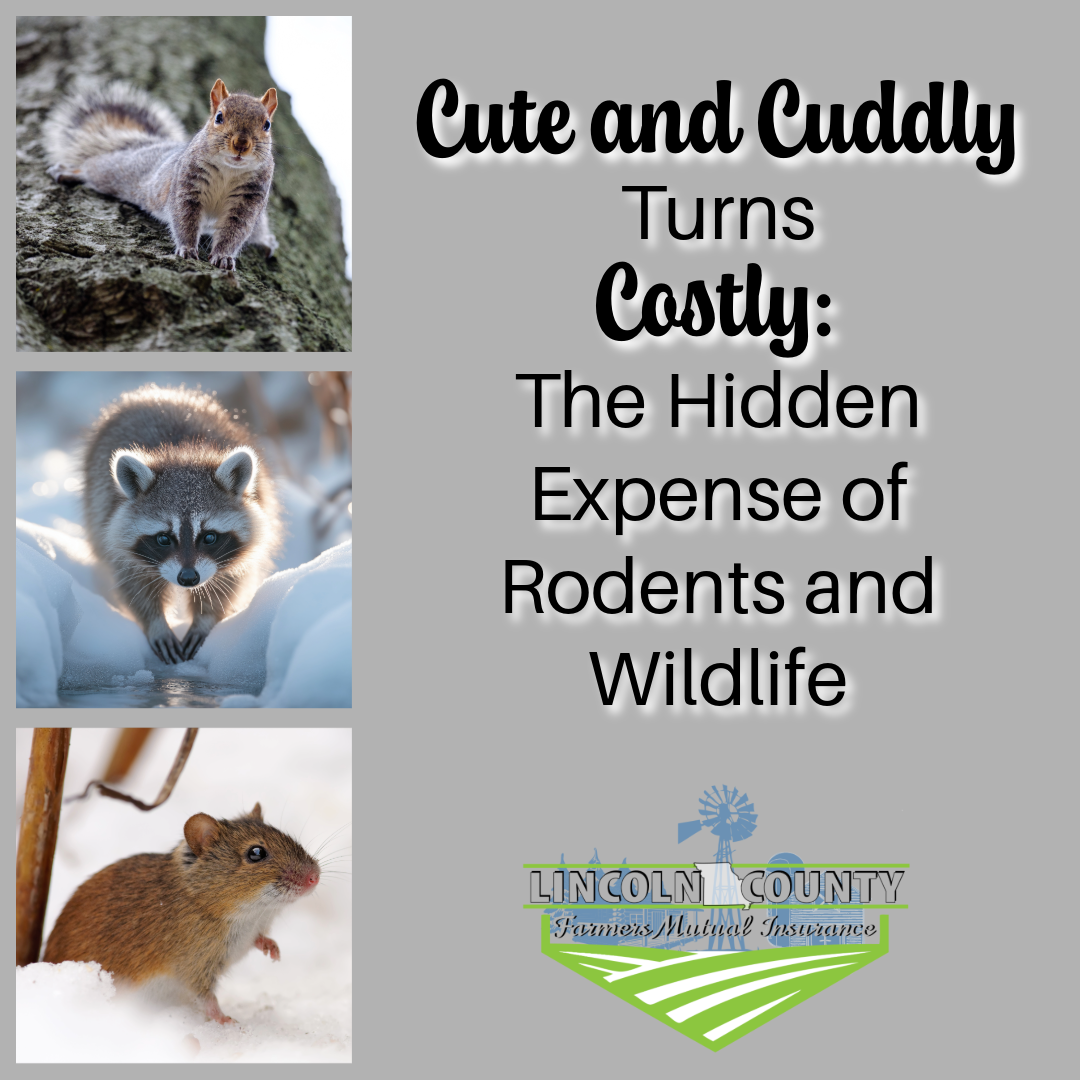There’s a reason we frequently emphasize the importance of inspecting your home and structures for signs of critters. Damage from smaller pests like squirrels, mice, and other rodents is generally not covered by homeowners insurance policies because infiltration and infestation are considered preventable. If you have questions about what your policy covers in regard to pets, livestock, and wildlife, contact your insurance agent for a thorough review.
Wildlife issues can escalate quickly, causing extensive damage to vehicles, farm equipment, and homes. Common scenarios include mice building nests in engines, squirrels chewing through wiring, or raccoons nesting in attic spaces. These situations not only lead to costly repairs but can also pose safety risks such as fire hazards or equipment malfunctions.
Here are some best practices to help prevent wildlife and critters from wreaking havoc on your property:
- Seal Entry Points
Animals can squeeze through surprisingly small openings, so inspect your home’s foundation, walls, and roof for gaps, holes, or cracks. Use durable materials like steel mesh, hardware cloth, or concrete to seal these areas effectively. Don’t forget to check vents, chimneys, and around utility lines—common access points for critters.
- Install Barriers
Fencing can be a great deterrent to larger animals. Install barriers around the perimeter of your home, barn, or garden. To prevent burrowing animals like groundhogs and rabbits, bury the bottom of the fence at least a foot underground. Consider using materials like metal or welded wire for added durability.
- Remove Attractants
Critters are often drawn to food and shelter. Keep trash in sealed containers, clean up spilled pet food, and avoid leaving food outside. Compost piles should be securely contained, and bird feeders should be placed away from your house.
- Use Repellents
Repellents can discourage animals from approaching your property. Natural deterrents like predator urine, citrus peels, or peppermint oil work well for some species. Commercial animal repellents are also an option and can be tailored to specific pests.
- Maintain Landscaping
Overgrown vegetation provides shelter for wildlife. Regularly trim trees, shrubs, and grass to reduce hiding spots. Keep woodpiles and brush at least 20 feet from your home, as these can serve as nesting areas.
- Conduct Regular Inspections
Periodic inspections can help you catch and address animal activity before it becomes a major problem. Look for signs such as droppings, chewed wiring, or damaged insulation. Early detection can save you from more extensive damage down the line.
- Seek Professional Help
If you’re dealing with a persistent or severe wildlife issue, don’t hesitate to consult a pest control professional or wildlife removal expert. They can safely and humanely address the problem while helping you implement long-term preventative measures.
Signs of Wildlife Encroachment
Identifying signs of wildlife encroachment early can save you time, money, and headaches. Here are some common indicators for specific animals:
- Raccoons: Look for overturned garbage cans, torn insulation, or paw prints near entry points. Raccoons often leave behind droppings that are larger and more segmented than those of smaller animals.
- Mice: Tiny droppings, shredded paper or fabric, and gnaw marks on wood or wires are clear signs of mice. You may also hear scratching noises at night in walls or ceilings.
- Squirrels: Evidence includes chewed wires, scattered nuts, and nests made of leaves or twigs in attics or vents. Squirrels are also known for damaging vehicle wiring.
- Armadillos: These animals dig extensive burrows, which can undermine foundations or landscaping. Signs include small, conical holes in the yard or disturbed soil near plants.
- Bats: Watch for guano (bat droppings) near entry points like rooflines or vents. A strong ammonia smell is another indicator, as is hearing squeaking noises at dusk.
- Skunks: The most obvious sign is their strong, unmistakable odor. Skunks may also dig small holes in lawns while foraging for insects or leave visible tracks with five toes and claw marks.
Wildlife around the home or farm can be fascinating to observe, but when animals begin to damage property, they become a costly nuisance. By taking proactive steps to secure your property, you can reduce the likelihood of critter-related damage and ensure the safety of your family, pets, and equipment. Don’t wait until you have a problem—start protecting your property today! Please know that we continuously work to adapt and offer competitive and comprehensive coverage for our customers. At Lincoln County Farmers Mutual Insurance Company, we’re proud to protect what matters most to you. For over 120 years, we’ve been a trusted part of the community, offering insurance solutions that help our policyholders feel secure. From our roots in Lincoln County, the expansion into Pike County, Warren County, and Montgomery County, to now serving all of Missouri, we’re here to inform, support, and protect. If you have questions or want to explore ways to optimize your policy, we’re here to help.


